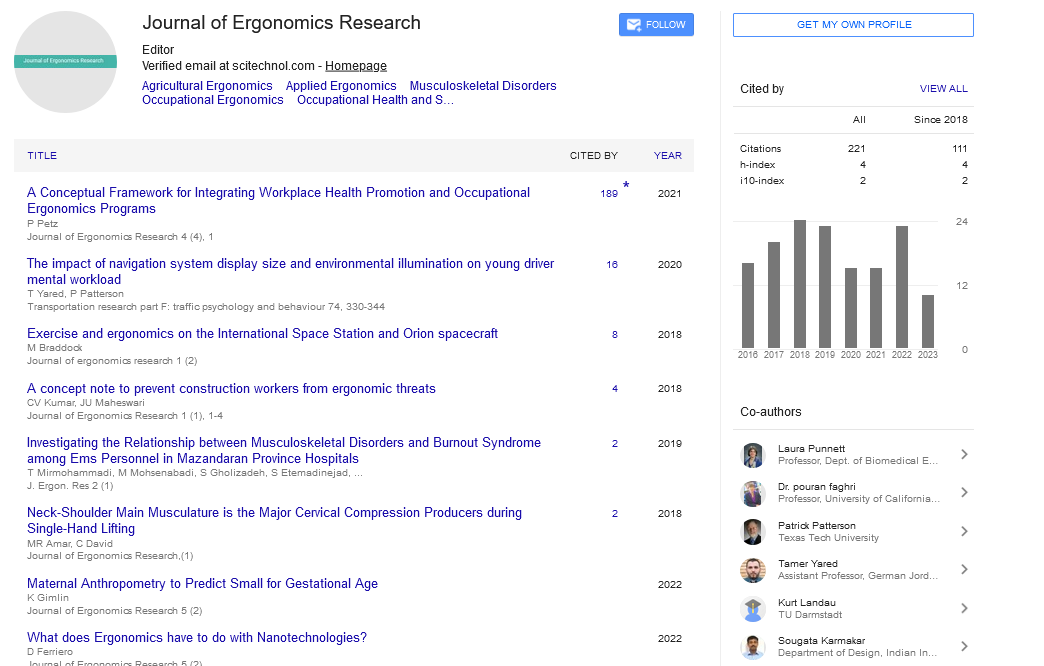Commentary, J Ergon Res Vol: 4 Issue: 6
General Methods of Control Available to the Industrial Hygiene Engineer
Gary Bennett*
The University of Toledo, Department of Chemical and Environmental Engineering, Toledo, USA
- Corresponding Author:
- Gary Bennett
The University of Toledo, Department of Chemical and Environmental Engineering, Toledo, USA
Tel: +185282643746;
E-mail: Bennett 38@gmail.com
Received date: 07 November, 2021; Accepted date: 22 November, 2021; Published date: 30 November, 2021
Keywords: Kinesiology, Musculoskeletal Disorders, Neuroergonomics
Description
Organizations are responsible for the overall health and safety of the workers they employ, from storehouse workers to the superintendent suite at their divisions. Keeping workers safe and healthy requires knowledge of artificial hygiene, which is the wisdom devoted to the expectation, recognition, evaluation, communication, and control of environmental stressors in the plant that may affect in injury, illness, impairment, or else affect the good of workers and community members, Because artificial hygienists are trained to estimate safety enterprises and find results to problems, it's important that directors at all situations and across functions are suitable to effectively work with and manage artificial hygienists. Whether you have an artificial hygienist on your platoon or you have to hire an outside company for an assessment, being suitable to speak the language of artificial hygienists will allow you to have a deeper understanding of implicit health and safety issues. In addition, once an artificial hygienist has recommended a course of action to correct any real or implicit issues, you'll be the one responsible for icing they're enforced in your plant.
Inner Air Quality
Indeed if you aren't working directly with an artificial hygienist, these principles can help you effectively incorporate the health and safety enterprises of artificial hygiene, similar as ergonomics, into the design and operation of your business [1]. By incorporating these principles beforehand in the planning process and being suitable to fete implicit issues before they escalate, you'll help insure the health and safety of your workers, and manage your company’s exposure to implicit threat and liability. Artificial hygiene, as stated over, is concerned with relating, assessing, and controlling real or implicit plant environmental stressors or hazards that can affect the good of workers and community members. It's occasionally called Occupational Hygiene, Occupational Health or Workplace Health. Immaculately, hazards are linked and controlled when a plant is being planned, when conditions or processes change, or through monthly reviews, before they come an issue for workers taken into consideration in an optimization system and enhance the delicacy of a model still jointly its complicatedness [2].
Chemical Exposure
Chemical hazards can take numerous forms, from liquid to smothers to dusts, and can be absorbed, gobbled, or ingested into a worker’s system. Some common chemicals that can potentially be dangerous are drawing products, gasoline, and fungicides. Numerous chemicals can be inoffensive in small boluses, but indeed some common chemicals can beget symptoms in those who are particularly sensitive, and utmost chemicals can beget adverse goods in large boluses or when proper safety preventives aren't taken [3]. These preventives include ventilation, particular hygiene similar as hand washing, which can reduce the quantum of chemicals absorbed by the skin, and maintaining outfit in order to help leaks and breakdowns.
In order to help insure proper artificial hygiene and therefore the health and safety of your workers, you can employ an artificial hygienist. The part of an artificial hygienist is to anticipate health and safety enterprises and design results to help them. They're the guardians of plant safety applying wisdom to identify and break health and safety problems. Industrial hygienists also unite operation, workers and all parts of a company behind the common thing of health and safety [4]. The American Board of industrial hygiene certifies artificial hygienists, furnishing a well admired standard in the field. An artificial hygienist will use rigorous scientific styles to estimate and control hazards in the plant, including threat assessment tools and information, similar as Safety Data Wastes, which are put together by chemical manufacturers and contain detailed information about each chemical [5]. Industrial hygienists can also conduct a worksite analysis to estimate all jobs, operations, ministry, and work conditioning at that point, in addition to problem working on specific conditioning or work areas.
References
- Abdulghafour, Yasmin A, Bo-Hamra, Anwar M, Al-Randy, et al. (2011) Burnout Syndrome among Physicians Working in Primary Health Care Centers in Kuwait. Alexandria J Medicine 47: 351-357.
- Sotodeh AN, Bakhtiari AH (2006) Occupational exhaustion and its related factors in nurses and midwives of Semnan University of Medical Sciences. Scientific J Kurdistan University Med Sci 11: 77-83.
- Choobineh AR, Tabatabaei H, Behzadi M (2009) Musculoskeletal problems among workers of an Iranian sugar-producing factory. Int J Occup Saf Ergon 15: 419-24.
- Bos J, Mol E, Visser B, Frings-Dresen M (2004) Risk of health complaints and disabilities among Dutch firefighters. Int Archives of Occupational Environ Health 77: 373-382.
- Harkin M, Melby V (2014) Comparing burnout in emergency nurses and medical nurses. Clin Nurs Stud 2: 152-163.
 Spanish
Spanish  Chinese
Chinese  Russian
Russian  German
German  French
French  Japanese
Japanese  Portuguese
Portuguese  Hindi
Hindi 